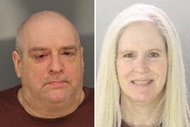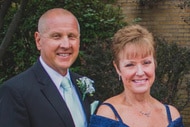Create a free profile to get unlimited access to exclusive videos, breaking news, sweepstakes, and more!
Who Are 'The Beatrice Six' And Why Did Many Of Them Confess To A Murder They Didn't Commit?
The new HBO series "Mind Over Murder" examines the false confessions from the case of three men and three women who were wrongfully convicted of the brutal 1985 rape and murder of 68-year-old Helen Wilson.

A new HBO original series examines why five out of six suspects confessed to killing a beloved grandmother, even though DNA would clear them all years later.
The 1985 murder of 68-year-old Helen Wilson is a dark stain on the history of Beatrice, Nebraska. The quaintness of the small midwestern town was shattered when, on a frigid Tuesday night in February, a killer (or, police believed, killers) entered Wilson’s first-story apartment and violently raped and suffocated the great grandmother to death.
“Mind Over Murder,” the new six-part docuseries, explores the hunches and dead ends of investigators who sought to catch those responsible for the murder. Eventually, the local sheriff's office landed on six individuals – Joseph White, Thomas Winslow, Jo Ann Taylor, Debra Shelden, James Dean and Kathy Gonzalez – described by Vanity Fair as “misfits.” Five falsely confessed to the heinous murder at the urging of authorities — including a mental health professional. The false confessions led to their convictions in 1989.
DNA would clear them in 2009 after they collectively spent 77 years behind bars: It showed that the blood at the scene and the semen in Wilson's body belonged to a man named to Bruce Allen Smith, who'd had a criminal record and whose grandmother lived in Helen Wilson's building at the time of her murder. He died seven years after Wilson's death, according to the New Yorker.
“The wrongful convictions were a product of both aggressive interrogations and flawed science, entangling more and more suspects as their false memories grew more fanciful,” The Washington Post wrote in 2019. “Most of the suspects were familiar with trauma in some way, according to the lawsuit. Some were mentally ill or intellectually challenged. And so for most, the idea that they could have repressed something terrible didn’t strike them as crazy.”
None of them could recall the violent night until officials like psychologist Dr. Wayne Price — who had assisted the Gage County Sheriff’s Office with its investigation — convinced the suspects that they couldn’t recall the events because the memories were so traumatizing.
When the group began “confessing,” the statements were inaccurate, at best. The details of the murder were wrong; who did what in Wilson’s apartment kept changing; and how the memories were extracted felt questionable.
Take, for example, James Dean, who initially denied playing a role in Wilson’s death. Dr. Price claimed Dean was “doubting the veracity of his own statements,” according to the New Yorker. Dean became convinced he could gain “visions of things” while napping.
Less than a week after his sessions with Price, Dean suddenly remembered he was an accomplice in Wilson’s murder.
“I feel that I remembered it in my sleep,” said Dean. “I had a memory loss, which just kind of just — I didn’t have no idea about none of this stuff.”
These confessions would be the only thing that tied anyone in the group to Helen Wilson’s murder.
“While there were serious inconstancies between the suspects’ stories and the details of the crime, no further investigation appeared necessary, especially once Dean, Shelden and Gonzalez falsely confessed after intense police interrogation,” according to the Innocence Project. “Dean and Shelden’s confessions relied heavily on details they allegedly recalled from their dreams about the crime.”
Joseph White, who did not confess, was the only suspect to go to trial for Wilson’s murder and was sentenced to life in prison after the jury found him guilty, according to The National Registry of Exonerations. After pleading guilty, Winslow was sentenced to 50 years behind bars; Taylor to 40 years; and Dean, Shelden and Gonzalez to 10 years.
Several filed appeal after appeal, but to no avail.
But in 2007, White and Winslow — serving the longest of the prison terms — successfully appealed their convictions and were allowed to have the semen found at Wilson’s apartment tested, according to the Registry.
Oklahoma forensic analysis Joyce Gilchrist had previously been tasked to compare Smith’s DNA to semen found at the crime scene but did not determine a connection.
Gilchrist, however, was eventually discredited for her work and found partly responsible for at least three other wrongful convictions, according to the Innocence Project. She was accused of forging evidence in hundreds of cases and was fired in 2001 for fraud, Fox Oklahoma City affiliate KOKH-TV reported. She died in 2015.
The newer examination found a concrete match between the crime scene evidence and Smith, who'd died in 1992. The new evidence was enough to overturn White’s conviction and convince a court to resentence Winslow to time served in 2008.
“There is no doubt in our minds that Bruce Smith is the lone perpetrator of this crime,” Beatrice Police Chief Bruce Lang later said, according to the Registry. (The Beatrice Police were removed from the case during the period of the arrests after questioning the direction of the county sheriff's office, according to the New Yorker.)
By January 2009, the state had pardoned all six of the wrongfully convicted individuals — the first six people to be exonerated on DNA evidence in Nebraska.
White — the one who'd always maintained his innocence — filed a civil rights lawsuit in 2009, according to the Washington Post, and a jury ruled in the group's favor. The state appealed, but the Supreme Court ruled the “Beatrice Six” should be awarded $28.1 million in damages.
White did not live to see the victory; he died in a construction accident in Alabama in 2011.



























